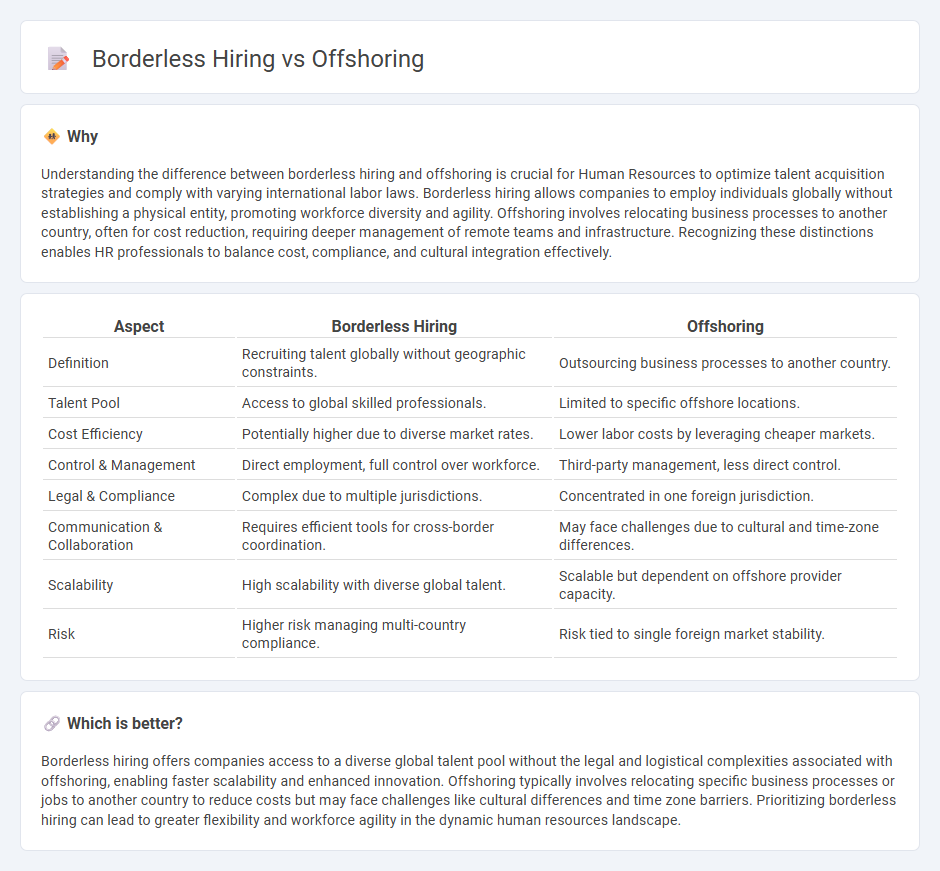
Borderless hiring enables companies to recruit top talent globally without geographic limitations, fostering diversity and innovation in the workforce. Unlike traditional offshoring, which shifts entire operations overseas to reduce costs, borderless hiring focuses on integrating remote professionals seamlessly into existing teams. Discover how this strategic approach transforms talent acquisition and business growth.
Why it is important
Understanding the difference between borderless hiring and offshoring is crucial for Human Resources to optimize talent acquisition strategies and comply with varying international labor laws. Borderless hiring allows companies to employ individuals globally without establishing a physical entity, promoting workforce diversity and agility. Offshoring involves relocating business processes to another country, often for cost reduction, requiring deeper management of remote teams and infrastructure. Recognizing these distinctions enables HR professionals to balance cost, compliance, and cultural integration effectively.
Comparison Table
| Aspect | Borderless Hiring | Offshoring |
|---|---|---|
| Definition | Recruiting talent globally without geographic constraints. | Outsourcing business processes to another country. |
| Talent Pool | Access to global skilled professionals. | Limited to specific offshore locations. |
| Cost Efficiency | Potentially higher due to diverse market rates. | Lower labor costs by leveraging cheaper markets. |
| Control & Management | Direct employment, full control over workforce. | Third-party management, less direct control. |
| Legal & Compliance | Complex due to multiple jurisdictions. | Concentrated in one foreign jurisdiction. |
| Communication & Collaboration | Requires efficient tools for cross-border coordination. | May face challenges due to cultural and time-zone differences. |
| Scalability | High scalability with diverse global talent. | Scalable but dependent on offshore provider capacity. |
| Risk | Higher risk managing multi-country compliance. | Risk tied to single foreign market stability. |
Which is better?
Borderless hiring offers companies access to a diverse global talent pool without the legal and logistical complexities associated with offshoring, enabling faster scalability and enhanced innovation. Offshoring typically involves relocating specific business processes or jobs to another country to reduce costs but may face challenges like cultural differences and time zone barriers. Prioritizing borderless hiring can lead to greater flexibility and workforce agility in the dynamic human resources landscape.
Connection
Borderless hiring enables companies to access a global talent pool beyond geographical limitations, while offshoring involves relocating specific business processes or jobs to foreign countries to leverage cost efficiencies and specialized skills. Both strategies optimize workforce allocation by utilizing international human resources, reducing operational costs, and enhancing competitive advantage. Leveraging advanced HR technologies and global compliance frameworks ensures seamless integration of remote employees and offshore teams within a unified organizational structure.
Key Terms
Talent Pool
Offshoring typically limits talent selection to specific countries where companies establish operations, whereas borderless hiring accesses a global talent pool unrestricted by geographic or political boundaries. This expansive approach enables businesses to tap into diverse skills, increase innovation, and fill roles faster by reaching professionals in various time zones. Explore how borderless hiring can redefine your recruitment strategy and access the world's best talent.
Cost Efficiency
Offshoring reduces labor costs by relocating operations to countries with lower wages, optimizing budget allocation for businesses. Borderless hiring expands access to global talent pools, providing cost efficiency through competitive salaries and reduced overhead expenses. Explore detailed insights into cost efficiency strategies for offshoring and borderless hiring to make informed workforce decisions.
Compliance
Offshoring involves relocating business operations to another country, often leading to complex compliance challenges with local labor laws, tax regulations, and employment standards. Borderless hiring bypasses these limitations by leveraging global talent pools through technology-driven platforms that ensure adherence to diverse legal frameworks with greater flexibility. Discover how modern compliance strategies can streamline global workforce management and reduce legal risks.
Source and External Links
Offshoring - Wikipedia - Offshoring is the relocation of a business process from one country to another, typically to reduce costs, access specialized talent, or enter new markets.
Offshoring: Definition, Overview, Pros and Cons - Velocity Global - Offshoring involves moving business operations to a different country, often to benefit from lower labor costs, global talent pools, and operational efficiencies.
Offshoring - Everything Policy - Briefs - Offshoring enables companies to cut expenses by shifting jobs and production to other countries, but it can also result in job losses in the home country.
 dowidth.com
dowidth.com